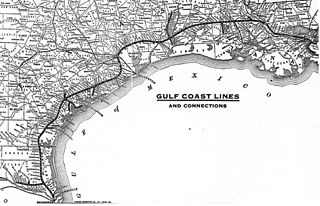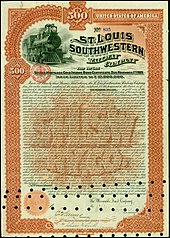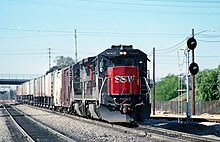
The Kansas City Southern Railway Company was an American Class I railroad. Founded in 1887, it operated in 10 Midwestern and Southeastern U.S. states: Illinois, Missouri, Kansas, Oklahoma, Arkansas, Tennessee, Alabama, Mississippi, Louisiana and Texas. KCS owned the shortest north-south rail route between Kansas City, Missouri, and several key ports along the Gulf of Mexico.

The Southern Pacific was an American Class I railroad network that existed from 1865 to 1996 and operated largely in the Western United States. The system was operated by various companies under the names Southern Pacific Railroad, Southern Pacific Company and Southern Pacific Transportation Company.

The Missouri Pacific Railroad, commonly abbreviated as MoPac, was one of the first railroads in the United States west of the Mississippi River. MoPac was a Class I railroad growing from dozens of predecessors and mergers. In 1967, the railroad operated 9,041 miles of road and 13,318 miles of track, not including DK&S, NO&LC, T&P, and its subsidiaries C&EI and Missouri-Illinois.

The Louisiana and Arkansas Railway was a railroad that operated in the states of Arkansas, Louisiana, and Texas. The railroad's main line extended 332 miles, from Hope, Arkansas to Shreveport and New Orleans. Branch lines served Vidalia, Louisiana, and Dallas, Texas.

The Texas and Pacific Railway Company was created by federal charter in 1871 with the purpose of building a southern transcontinental railroad between Marshall, Texas, and San Diego, California.

The Blacklands Railroad is a class III short-line railroad headquartered in Sulphur Springs, Texas.
Bird's Point is an unincorporated community in Mississippi County, Missouri, United States. It lies on an island or former island in the Mississippi River, near the confluence of the Ohio and Mississippi Rivers and is situated directly across from Cairo, Illinois. This is the point where the U.S. Route 60 bridge connects with Cairo.

Memphis Union Station was a passenger terminal in Memphis, Tennessee. It served as a hub between railroads of the Southwest, the Missouri Pacific Railroad and the St. Louis Southwestern Railway, and railroads of the Southeast, the Louisville and Nashville Railroad, the Nashville, Chattanooga and St. Louis Railway and the Southern Railway. The terminal, completed in 1912, was built in the Beaux-Arts style and was located on Calhoun Street, between south Second Street and Rayburn Boulevard. It was demolished in 1969. This location in south Memphis was approximately two blocks east of the other major Memphis railroad terminal, Memphis Grand Central Station.

Little Rock Union Station, also known as Mopac Station, is a train station in Little Rock, Arkansas, United States served by Amtrak, the national railroad passenger system.

Arkansas Railroad Museum is located on Port Road in Pine Bluff, Arkansas at the former Cotton Belt (SSW) yard.

The Morning Star was a passenger train operated by St. Louis Southwestern Railway between St. Louis and Dallas, designated as train numbers 5 (southbound) and 6 (northbound). From 1941 to 1950, the Morning Star also carried through cars from Memphis to Dallas, connecting with the main train at Brinkley, Arkansas. The Memphis connection for the Morning Star was added to permit Cotton Belt passenger trains to readily connect with the new Tennessean which had been inaugurated by Southern Railway in 1941. The Morning Star was replaced by unnamed train numbers 7 and 8 in November 1952, as a part of extensive passenger train restructuring by St. Louis Southwestern. The #7/#8 trains continued to the mid-1950s along the St. Louis - Dallas route, with coach and sleeping car service; however, food concession cars were eliminated.
The Stephenville North & South Texas Railway (SN&ST) was incorporated in Texas on February 4, 1907, by Stephenville and Hamilton business interests. Its original standard gauge 43-mile line was built between Stephenville and Hamilton and completed in late 1907. The first train operated between Stephenville and Hamilton on Christmas Day 1907. Regular service began in January 1908. Four apparently identical wooden depots of a standard design were built at Hamilton, Carlton, Spurlin, and Alexander. The SN&ST shared a Union Station with its original primary railroad connection, the long-established Fort Worth & Rio Grande Railroad at Stephenville.

The Gulf Coast Lines was the name of a railroad system comprising three principal railroads, as well as some smaller ones, that stretched from New Orleans, Louisiana, via Baton Rouge and Houston to Brownsville, Texas. Originally chartered as subsidiaries of the Frisco Railroad, the system became independent in 1916 and was purchased by the Missouri Pacific Railroad in 1925.

The St. Louis Southwestern Railway of Texas, operated the lines of its parent company, the St. Louis Southwestern Railway within the state of Texas. The St. Louis Southwestern, known by its nickname of "The Cotton Belt Route" or simply the Cotton Belt, was organized on January 12, 1891, although it had its origins in a rail line founded in 1871 in Tyler, Texas that eventually connected northeastern Texas to Arkansas and southeastern Missouri. Construction of the original Tyler Tap Railroad began in the summer of 1875, and the first 21 miles out of Tyler to Big Sandy, Texas were constructed by early October of 1887. The line became the Texas and St. Louis Railway, and was completed between Gatesville, Texas and Bird's Point, Missouri by August 12, 1883, creating a continuous 725-mile system. However, that line promptly went into receivership, and was purchased by the St. Louis, Arkansas and Texas Railway in 1886. The assets of that company were acquired out of foreclosure by the St. Louis-Southwestern Railway in 1891. The St. Louis Southwestern of Texas merged with the property of the Tyler Southeastern Railway on October 6, 1899. The property of the Texas and Louisiana Railway was acquired and merged on July 2, 1903.

The Yancopin Bridge is an abandoned railroad moveable bridge spanning the Arkansas River, and the last bridge across the Arkansas River before it flows into the Mississippi River 15 miles to the southeast. It is distinctive not only for its size and remoteness, but also for having not one but two movable spans, one having replaced the other due to river avulsion.
The St. Louis Southwestern Railway Caboose #2325 is a historic railroad caboose. It was built in 1920 by the St. Louis Southwestern Railway at its Pine Bluff, Arkansas shop, and is one of only a few surviving 2300-series cabooses. It was used by the railroad on its Paragould-Blytheville route and was acquired by the Paperton Junction Southern Railway in 1980 and restored.
The history of the Southern Pacific ("SP") stretched from 1865 to 1998.
Shreveport Union Station was a passenger station on Louisiana Avenue, at Lake Street, Shreveport, Louisiana. Built in 1897 by the Kansas City, Shreveport & Gulf Terminal Company, it was the oldest of Shreveport's four passenger railroad stations. With a tall tower, the station became a landmark in downtown Shreveport. It had its highest levels of service in the 1920s, typically hosting 35 passenger trains a day.
Originally incorporated as the Tyler Tap Railroad in 1871, the Texas and St. Louis Railway (“T&SL”) constructed a three-foot gauge railroad from Gatesville, Texas through Arkansas to Bird's Point, Missouri starting in 1875 and completing by 1883. One of the two longest narrow-gauge lines in the country, the railroad went into receivership in early 1884, and another railway had acquired its trackage by 1886.
The Paragould Southeastern Railway (“PSR”), originally the Paragould and Buffalo Island Railway, was an industrial line initially started to carry timber products from lands east of Paragould, Arkansas, into town. It acquired its first trackage in 1887, and eventually extended its line to Blytheville, Arkansas, over 37 miles from Paragould. The trackage was absorbed into the St. Louis Southwestern Railway, known as the “Cotton Belt,” in 1914.



















